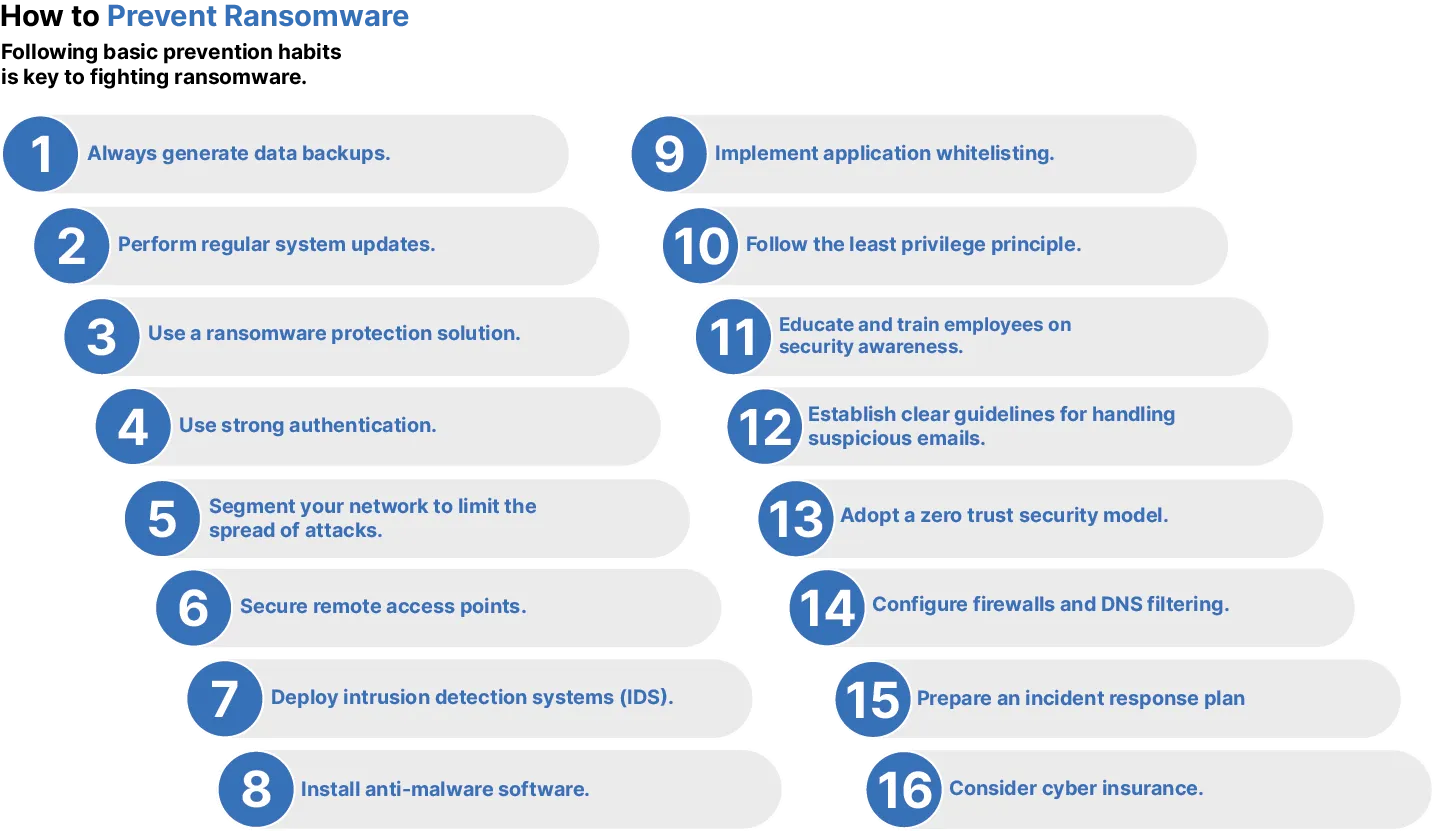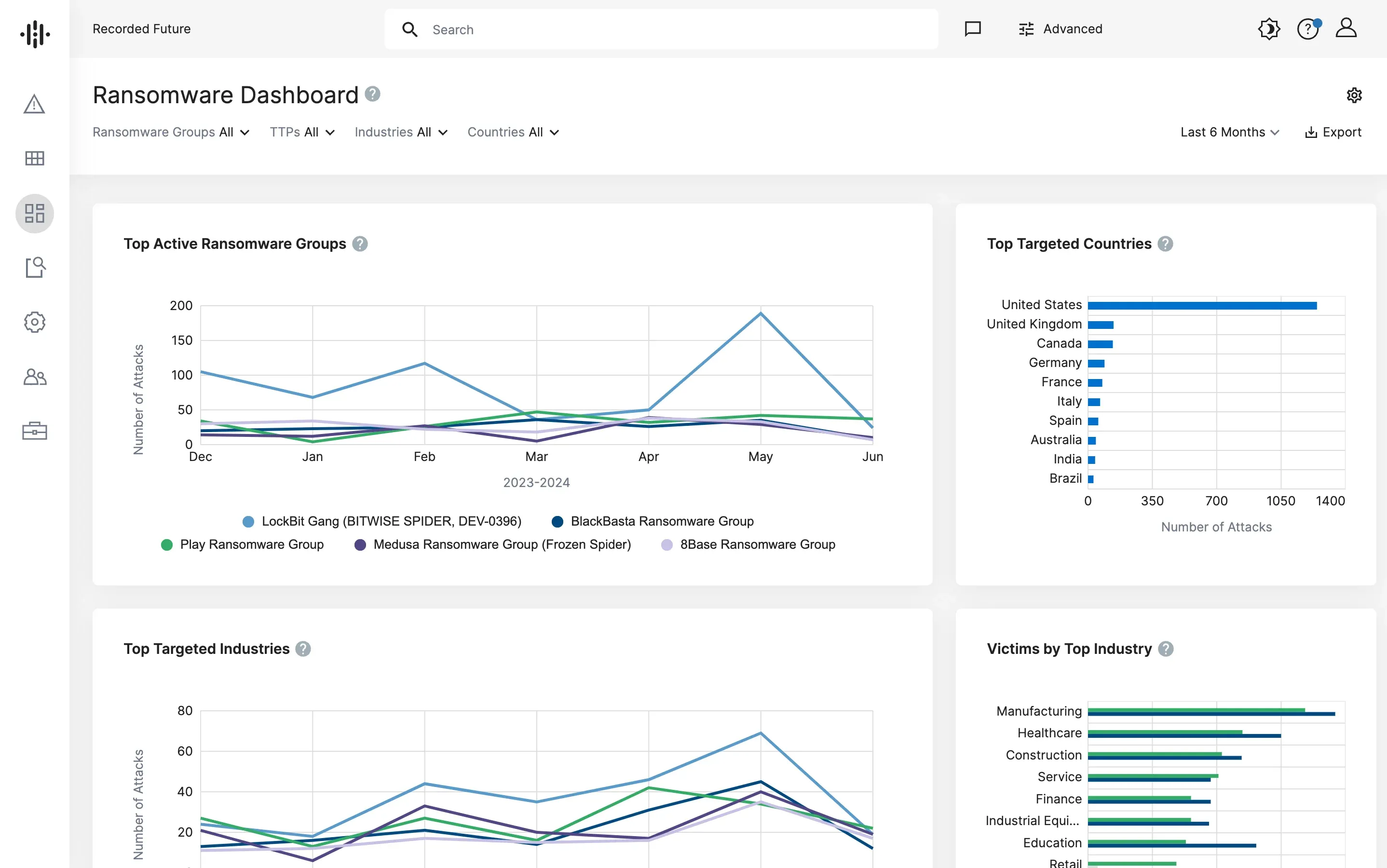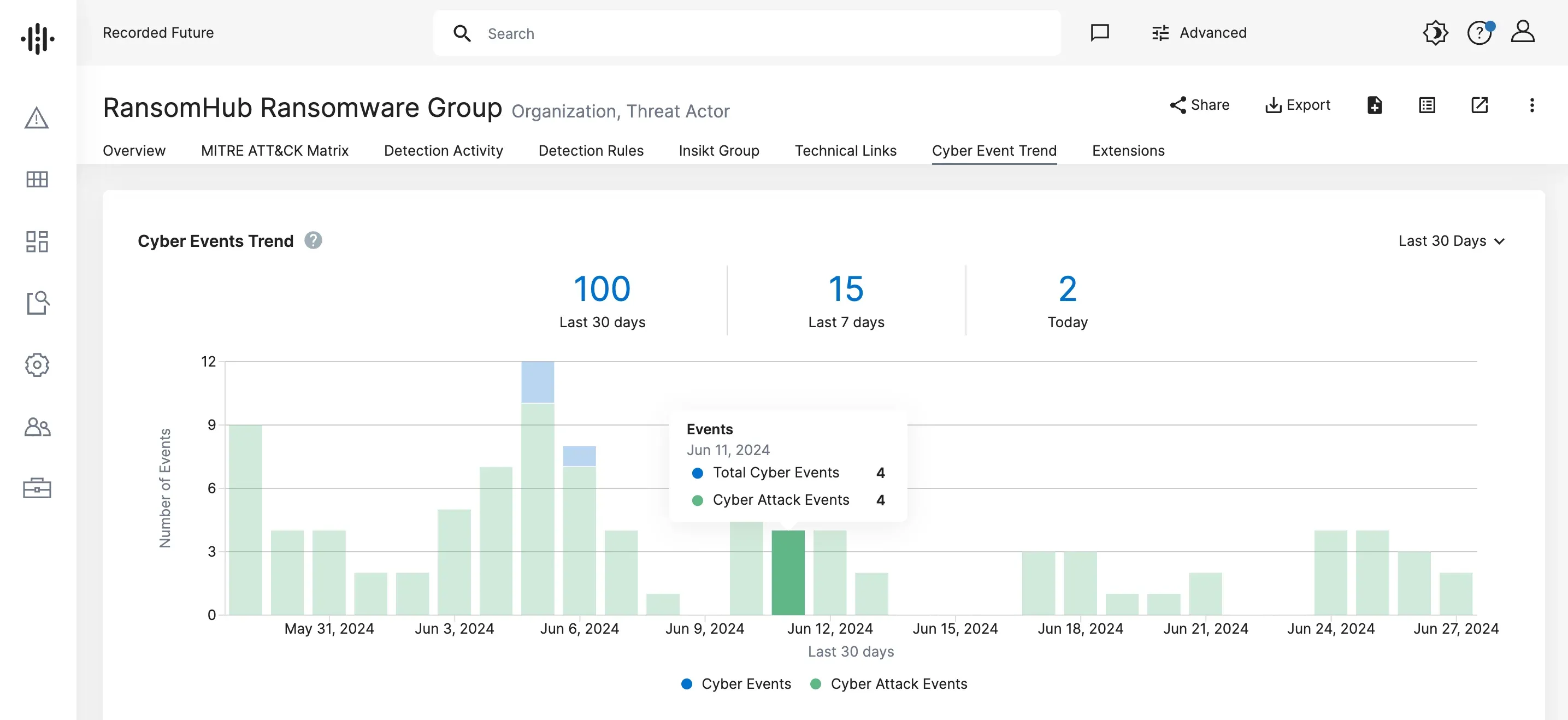How to Prevent Ransomware Attacks: Top Steps and Tips
Ransomware is one of the biggest threats out there, capable of grinding your business to a halt by hijacking your data and demanding a ransom. It’s crucial to stay ahead of these attacks to keep your organization running smoothly. In this post, we'll dive into some practical steps and expert tips to help you understand ransomware and, more importantly, how to stop it in its tracks.
Quick Facts
- Follow basic prevention habits like data backups, system updates and strong authentication to minimize ransomware risk.
- Harden your network with network segmentation, remote access and intrusion detection.
- Educate and train employees on security awareness, do regular drills and have clear guidelines for handling suspicious emails to reduce ransomware infections.
About Ransomware
Ransomware is a malware that:
- Locks systems, devices or files until a ransom is paid
- Uses file encryption on the endpoint as one of the methods
- Threatens to delete files or block system access altogether
- Is the most common and visible type of malware
- Affects critical services and causes damage to many organizations
Ransomware has evolved to double extortion and triple extortion and many ransomware variants. Here are the highlights:
- Double extortion ransomware encrypts data and steals it and threatens to leak the stolen data if the ransom is not paid.
- Triple extortion adds another layer, such as demanding ransom from the victim’s customers or partners or launching DDoS attacks.
- The WannaCry outbreak of 2017 was a turning point, proving the profitability and global impact of ransomware attacks.
Numbers are scary:
- As of 2023, 72% of companies have been hit by ransomware
- Average cost per incident is $4.35 million
- Education and research sector was the most attacked
- Government/military and healthcare sector were also heavily hit
The cost of ransomware attacks are financial loss, data loss, downtime, brand damage and potential legal penalties.
%20ebook%20-%20Landing%20page.webp?width=188&height=300&name=2024_0627-%20transparent%20Ransomware-%20Understand.%20Prevent.%20Recover%20(Third%20Edition)%20ebook%20-%20Landing%20page.webp)
Ransomware: Understand. Prevent. Recover.

Basic Prevention Habits
Following basic prevention habits is a key to fighting ransomware. These habits are data backups, system updates and strong authentication. By doing these you can minimize the risk of getting hit by ransomware.
Data backups ensure you have copies of your critical data that can be restored in case of attack. System updates closes security vulnerabilities that ransomware actors can exploit. Strong authentication like multi-factor authentication (MFA) prevents unauthorized access to your systems.
Data Backups
Any ransomware prevention strategy must prioritize data backups. Backing up critical data at least once a day can minimize data loss in case of ransomware attack. These backups are a safety net so you can restore your systems and data without paying ransom.
Keeping offline backups is important because it ensures your backup files are not accessible to ransomware that may infect your network. Offline backups can be stored on external hard drives or other storage devices that are not connected to your main network. And using immutable cloud storage adds another layer of protection as these backups cannot be modified or deleted by ransomware.
Do these backups as part of your routine and you’ll be protected and can recover fast from an attack. Remember, the goal is to make your backup process as foolproof as possible so the impact of ransomware infection is minimal.
System Updates
Another key to ransomware prevention is system updates. Updating and patching software and operating systems is critical to close vulnerabilities that ransomware actors can exploit. Outdated systems are ransomware’s favorite target, as seen in WannaCry where the attack exploited a known Microsoft Windows vulnerability (CVE-2017-0145).
System administrators should prioritize updating and patching systems and devices to fix known bugs and vulnerabilities in software, firmware and operating systems. This will close security gaps and reduce the attack surface that ransomware can hit. Having an up-to-date operating system is critical as security experts advise to update software immediately to prevent ransomware from exploiting.
To be fully protected, CISA recommends using a combination of vulnerability scanning and continuous monitoring to detect and fix vulnerabilities. By being vigilant and proactive in updating your systems you can minimize the risk of ransomware attacks.
Ransomware Protection Solution
Combining these best practices with Recorded Future's proactive ransomware mitigation solutions provides a comprehensive defense against ransomware. Recorded Future offers continuous monitoring and automated alerts for vulnerabilities, ensuring that security gaps are swiftly addressed. Our advanced threat intelligence helps you stay ahead of potential ransomware attacks, keeping your systems secure and your data protected.

The proactive approach from our platform also includes detailed threat analyses and real-time insights, empowering your organization to respond quickly and effectively to emerging threats. By integrating our cutting-edge technology into your cybersecurity strategy, you can enhance your overall defense posture and reduce the risk of costly ransomware incidents.

Strong Authentication
Securing and preventing unauthorized access requires strong authentication. Multi-factor authentication (MFA) adds another layer of security by requiring multiple forms of identification from users. So even if the password is compromised, the attacker still needs another form of verification to get in.
Using MFA on remote access tools and VPNs reduces ransomware attacks. It’s recommended to secure all services, especially critical systems access. Password managers can also minimize risks by preventing users from reusing passwords across different platforms.
By using strong authentication and security measures you can protect your data and systems from unauthorized access and prevent malicious actors from deploying ransomware.
Network Security
To protect your organization from ransomware attacks you need to harden your network. Network segmentation, securing remote access and deploying intrusion detection systems are key to fortify your network. Implementing technologies such as SPF, DKIM, and Domain Message Authentication Reporting and Conformance (DMARC) can prevent malicious actors from using email spoofing techniques, thereby reducing the risk of phishing emails that could lead to ransomware attacks.
Network segmentation is dividing your network into smaller, isolated segments to limit the lateral movement of ransomware within the network. Securing remote access methods like Remote Desktop Protocol (RDP) by changing default ports and enabling MFA can prevent unauthorized access.
Also, deploying an intrusion detection system (IDS) will give you early warning of suspicious activity so ransomware can’t get a foothold in your network.
Network Segmentation
To limit the spread of ransomware in your network consider the powerful approach of network segmentation. By dividing your network into smaller, isolated segments you can reduce the attack surface and make it harder for ransomware to move laterally.
Network segmentation can:
- Isolate ransomware attacks
- Prevent them from spreading across the network
- Create isolated zones in a network to limit the spread of breaches
- Protect sensitive data.
Remote Access
Securing remote access is critical to prevent ransomware attacks. Remote Desktop Protocol (RDP) is often used by hackers to gain unauthorized access and deploy ransomware. Changing default ports for RDP and enabling MFA can minimize unauthorized remote access.
To minimize entry points for ransomware follow these steps:
- Disable unused remote access services.
- Update and patch remote access tools and VPN software to close vulnerabilities that ransomware can exploit.
- Scan remote access tools for vulnerabilities to detect and mitigate security gaps.
By doing this you can harden your remote access systems and minimize the risk of ransomware attacks.
By securing remote access you can prevent malicious actors from getting into your network and deploy ransomware.
Intrusion Detection Systems
To protect your network from ransomware consider the proactive approach of deploying Intrusion Detection Systems (IDS). IDS can:
- Compare network traffic logs to known malicious activity signatures
- Give early warning of suspicious activity
- Identify potential security threats before they escalate
- Allow organizations to respond quickly and prevent ransomware from getting a foothold in the network.
Updating IDS signatures regularly ensures the system can detect the latest threats and alert security personnel. By deploying IDS you can harden your network and prevent ransomware threats.
Endpoint Security
As a business grows and the number of endpoints increases, endpoint security becomes critical. Prioritizing endpoint security prevents unauthorized access to private data and the main network. This means installing anti-malware software, enabling application whitelisting and practicing the least privilege principle.
Unified endpoint management (UEM) allows centralized management of IT infrastructure, security through unified endpoint verification tools. Managed service providers can benefit greatly from UEM solutions in their service offerings.
UEM benefits:
- Centralized management of IT infrastructure
- Security through unified endpoint verification tools
- Configure systems with security in mind to minimize the organization’s attack surface and close security gaps from default configurations.
Anti-Malware Software
One of the basic steps in defending against ransomware attacks is to** install security software, anti-malware software**. A centrally managed antivirus solution is recommended to detect both precursor malware and ransomware. Auto update antivirus and anti-malware software to escalate warnings and indicators to security personnel.
By auto updating you can detect and block ransomware before it causes damage. This proactive approach will protect your systems from ransomware infections.
Application Whitelisting
To prevent ransomware attacks application whitelisting is a good approach. It means determining which applications can be downloaded and executed on the network and restricting or blocking unauthorized programs or websites. Using allowlisting means only authorized software can be executed and all unauthorized software is blocked.
For Windows systems enabling Windows Defender Application Control (WDAC) or AppLocker can be effective for application allowlisting. By implementing application whitelisting you can prevent ransomware by blocking unauthorized software and disable Windows Script Host to further harden security.
Least Privilege Principle
Ransomware spread can be controlled by practicing the least privilege principle. This means limiting user access to only the data they need for their role. Restricting user permissions to access or modify cloud resources is security.
Auditing user and admin accounts regularly to ensure they have minimal privileges is key to reducing ransomware risk. By separating admin accounts from user accounts you can further limit permissions and harden security.
Educate and Train Employees
A ransomware prevention strategy is incomplete without educating and training employees. Cyber threat intelligence training and security awareness training teach the security team and other team members to:
- Spot and avoid malicious emails
- Recognize phishing attempts
- Use strong, unique passwords
- Auto update software and systems
- Backup important data
- Report suspicious activity
By educating and training employees you can reduce ransomware risk. Employees are the weakest link in the security chain, human error is a big risk.
Include employee education in your overall cybersecurity strategy and be proactive towards digital threats. This means conducting security awareness training and developing suspicious email policies.
Security Awareness Training
Ransomware prevention requires security awareness training. Regular updates and drills will keep employees aware of the latest threats and know how to respond. Training should cover basic topics like password security, anti-phishing techniques and social engineering.
Training employees to identify and report suspicious emails is key to preventing phishing attacks that can lead to ransomware infections. Employees should be trained to be cautious of emails from unknown sources and report suspicious ones.
Suspicious Email Policies
Clear guidelines for handling suspicious emails can reduce the risk of malware infections including those caused by malicious code from phishing attacks. Policies should include guidelines on how to identify and handle emails with malicious links and attachments.
Training employees on how to handle suspicious emails is key to reducing ransomware risk. By having suspicious email policies you can create a safer email environment.
Advanced Security Tools
A defense-in-depth strategy against ransomware attacks requires using advanced security tools. A multi-layered approach will detect and mitigate malware before it can cause damage. This means implementing zero trust security model and configuring firewalls and DNS filtering.
Advanced security tools like endpoint detection and response (EDR) and centralized log management will help you to identify, investigate and respond to security threats at endpoint level. By using these tools you can harden your defenses and protect your data from ransomware threats.
Zero Trust Security Model
Operating under zero trust security model, nobody inside or outside the network is trusted without verification. This model enforces strict access controls and assumes the network is already compromised, so minimizes risk.
Zero trust architecture means verifying user identities at every access point through multi-factor authentication and enforcing least privilege access decisions. This will prevent unauthorized access and protect your data from malicious actors.
Firewalls and DNS Filtering
Firewalls are the first line of defense against incoming attacks and filter out and block suspicious data packets. Configuring firewalls to block unnecessary SMB communications will prevent ransomware from spreading across the network.
DNS filtering will block access to known malicious domains, preventing users from accessing malicious sites. Protective DNS services analyze DNS queries to mitigate threats like ransomware and phishing. By configuring firewalls and DNS filtering you can harden your network and protect against ransomware threats.
Be Prepared
Preparing for potential ransomware incidents means having an incident response plan and considering cyber insurance. Having a plan in place means your organization can monitor, detect and respond to ransomware attacks.
Having an incident response plan means designating roles, establishing clear communication channels and having the plan offline. Cyber insurance will cover the financial impact of ransomware incidents, response costs, lost revenue and customer notification expenses.
Incident Response Plan
Having an incident response plan is key to managing ransomware risk and coordinating the response. The plan should cover monitoring, detection and response to ransomware incidents, including backups, recovery and communications. Designate roles for employees in the incident response plan and provide detailed instructions, including roles and communications. Engage internal and external teams to help with mitigation and recovery and consult federal law enforcement for decryptors.
Resetting credentials including passwords is required after a ransomware attack to prevent further unauthorized access. To adapt to changing environments and evolving ransomware tactics, you should run regular security testing.
Cyber Insurance
To mitigate the financial impact of ransomware attacks, consider cyber insurance policies. Cyber insurance covers extensive financial losses and costs associated with these attacks, including legal fees, forensic investigations and lost revenue due to business interruption.
Policies will also cover costs of notifying affected customers and providing credit monitoring services after a data breach. When choosing a cyber insurance policy, businesses should consider the coverage options available and make sure they match their needs.
FAQs
How do I prevent ransomware attacks?
To prevent ransomware attacks you should implement basic prevention practices like data backups, keep systems up to date, strong authentication and employee education.
What are the benefits of segmentation?
Segmentation reduces the attack surface, makes it harder for ransomware to spread within the network and helps isolate ransomware attacks, overall more secure the network.
Why is employee education important?
Employee education is important because it empowers employees to recognize and prevent malicious emails, reduces the risk of ransomware attacks and overall security.
What should be in the incident response plan?
Your incident response plan should cover monitoring, detection and response to ransomware incidents, backups, recovery and communications.
Wrapping up
In summary, to prevent ransomware attacks, you need a multi-layered approach, regular data backups, updated systems, strong authentication methods, and robust network security. Endpoint security, employee education and training, advanced security tools, and being prepared for potential incidents are also key.
By following these best practices, you can minimize the chance of being a ransomware victim and be ready to respond to any threats.
Remember, the key to ransomware prevention is to stay vigilant, proactive, and informed.
Arm your organization with Recorded Future's proactive ransomware protection solutions to stay ahead of cyber threats and ensure your digital safety. Book a demo today and see how we can safeguard your business.
Related News & Research



